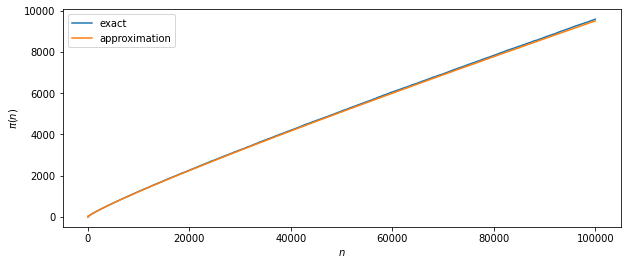The aim of the exercise is to decompose the factorial of n, $n!$, into its prime factors.
Examples:
- for $n = 12$, the decomposition should give
2^10 * 3^5 * 5^2 * 7 * 11; - for $n = 22$, the decomposition should give
2^19 * 3^9 * 5^4 * 7^3 * 11^2 * 13 * 17 * 19; - for $n = 25$, the decomposition should give
2^22 * 3^10 * 5^6 * 7^3 * 11^2 * 13 * 17 * 19 * 23.
Prime numbers should be in increasing order. When the exponent of a prime is 1 don’t put the exponent.
The first part of this exercise is to be able to compute all the factors of a number $i$ using a function
prime_factors(); computing the
factors of $n! = 1 \times 2 \times 3 \times \cdots \times n$ is then just applying the factorization for each $i$ in for loop with some bookkeeping.
The factorization of a number is quite easy and can be found in lots of places, like this stackoverflow answer. Just applying this function naïvely, though, can be inefficient for large values of $n$. We solve the problem by making sure that prime_factors() goes through all the numbers rercursively and by adding a cache to avoid repeated calls.
from collections import defaultdict
from functools import lru_cache
import matplotlib.pylab as plt
import numpy as np
@lru_cache(maxsize=None)
def prime_factors(n):
i = 2
factors = []
while i * i <= n:
if n % i:
i += 1
else:
n //= i
factors += prime_factors(i)
if n > 1:
factors.append(n)
return factors
Before solving the exercise, we can have some fun and plot the number of prime numbers in the interval $[1, n]$, usually indicated with $\pi(n)$. It is well-known that $\pi(n) \approx \frac{n}{\ln n + 1}$.
x = list(range(2, 100_000))
y = []
for i in x:
factors = prime_factors(i)
y.append(0 if len(factors) > 1 else 1)
plt.figure(figsize=(10, 4))
plt.plot(np.cumsum(y), label='exact')
plt.plot(x, x / (np.log(x) - 1), label='approximation')
plt.legend()
plt.xlabel('$n$')
plt.ylabel('$\pi(n)$');
Text(0, 0.5, '$\\pi(n)$')

The solution of the exercise is now quite simple and is implemented below. The function factorial_decomposition() has two parts: in the first we compute the decomposition; in the second we assemble it in the required format.
def factorial_decomposition(n):
decomp = defaultdict(lambda: 0)
for i in range(2, n + 1):
factors = prime_factors(i)
for factor in factors:
decomp[factor] += 1
keys = sorted(decomp.keys())
retval = []
for key in keys:
value = decomp[key]
if value == 1:
retval.append(str(key))
else:
retval.append(f'{key}^{value}')
return ' * '.join(retval)
We can check the examples at the top:
assert factorial_decomposition(12) == '2^10 * 3^5 * 5^2 * 7 * 11'
assert factorial_decomposition(22) == '2^19 * 3^9 * 5^4 * 7^3 * 11^2 * 13 * 17 * 19'
assert factorial_decomposition(25) == '2^22 * 3^10 * 5^6 * 7^3 * 11^2 * 13 * 17 * 19 * 23'
The code is quite fast, also for large factorials. Calling factorial_decomposition(40_000) is a fraction of a second; on the slow computer I am using factorial_decomposition(400_000) is just above 5 seconds, which is still not bad.